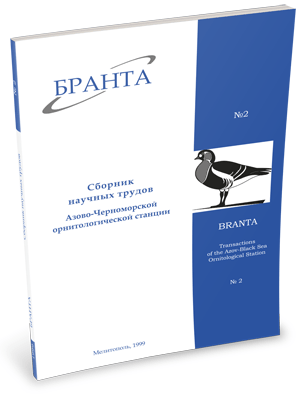
Transactions
of the Azov-Black Sea Ornithological Station



Present state of Bluethroat in Odessa region
Korzukov A.I., Trifonov V.G., Koval L.K.
Material was collected in the northern part of the Odessa region (the Balta district) in 1985-1994.The earliest arrival of liluethroats to the breeding area was observed on 18.03.89, the latest – on 8.04.87. Dates of the first spring observation of Bluethroats in the north of Odessa region are the following – 6.04.85, 4.04.86, 8.04.87, 30.03.88, 18.03.89, 2.04.90,5.04.91, 7.04.92, 7.04.93, 2.04.94. Dates of the first arrival in the southern areas are – 10.06.96 (Budakski Liman) and 2.04.99 (Liman of Kuyainik, the lower reaches). Mates arrive 10-15 days earlier than females.Preferable breed ini’ habitats in Kodyma River Jlood-lands are areas overgrown with reed and mace, 30-40 metres long. Bhiethroats build their nests on the ground in sedge associations or in thick grass under tussocks. Five breeding territories were counted per I km of Jlood-lands. Distance between breeding territories is 30-450 m. Estimated average density in the flood-lands (their width is 500-600 m) is 5-6 breeding pairs per 1 km.
Nest-building behaviour was observed on 9.05.93. Birds flew up to the nest with average intervals of 30-40 seconds. Building was finished by 13 May. First egg was found in the nest on 14 May. Complete clutch of 6 eggs was laid by 18 May. Clutch was incubated by a female. Duration of uninterrupted incubation interval was 1-1.5 hours. Feeding bouts took from a few minutes to a half an hour. Chicks hatched on 30 May. Bicyclic breeding was observed in the study region.Limiting factors during the breeding period are anthropogenic influence and the weather conditions.
Read the paper in a PDF file